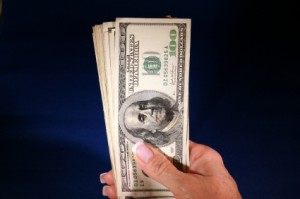 Choosing your cash-back credit card takes a little more study and investigation than you might think, because the features vary from one to another. In fact, some of them that offer big rewards might not pay off at all – ever.
Choosing your cash-back credit card takes a little more study and investigation than you might think, because the features vary from one to another. In fact, some of them that offer big rewards might not pay off at all – ever.
The first thing to watch for is an annual fee. If you have to pay to carry the card you might have to spend quite a bit just to break even. So unless that annual fee offers some other benefit, such as an extremely low interest rate, you probably want to keep looking.
Next is the kind of cash-back. Is it actual cash, or is it points? If it’s points, how many do you have to accumulate before you can turn them into cash?
Some cards offer cash-back but with a combination of expiration dates and payment thresholds that mean you have to spend a lot in order to ever see the cash back. If the threshold is say, $100 and you’re earning 2%, you’d have to spend $5,000 before you get your rebate. And if your rewards expire at the end of each twelve month period, you could have spent $4,900 without seeing a dime returned to you.
You want rewards that roll over from one year to the next, or that automatically pay out at the end of the period, no matter if you’ve only “earned” $20.
Check to see how you go about getting your cash back – will they automatically send a check or credit your account? Will you have a choice of how to receive it? Or will you need to fill out rebate forms in order to get your money?
If you use your card for business and thus charge and pay off large amounts each month, it makes sense to use a card that rewards you. But be careful, some credit card issuers put a cap on how much you can earn. Some cap your earnings at $300 per year.
Look for restrictions. If the card rewards grocery, gasoline, or restaurant purchases, don’t assume that just because you bought groceries, gas, or a meal that the purchase will qualify. Many of the credit card issuers have significant and surprising limitations with regard to which stores, gasoline outlets, or restaurants qualify.
The bottom line is that if you want to get a card that fits your lifestyle, and will truly give the promised cash back, you have to read all the fine print. It isn’t easy – those agreements are filled with legaleze and the print is minute, but reading it all is the only way to know if you really are going to get what you expect.
 The Discover® Open Road Card is a rewards credit card for consumers with credit scores of 700 and above.
The Discover® Open Road Card is a rewards credit card for consumers with credit scores of 700 and above.
With no annual fee, a zero percent interest rate for the first 6 months, and generous Cashback rewards, it makes good sense to transfer your high rate credit card balances with your application, and to use this credit card for purchases.
Rewards points are double when you use your Open Road card for gasoline or restaurant purchases, and as high as 20% when you use your card at top retailers through Discover’s® online shopping mall.
Your Cashback rewards can be redeemed for partner gift cards, Discover® gift cards, for merchandise, for credit to your Discover® card account, or by an electronic deposit to your bank account.
Your Cashback rewards count for even more when you redeem them for gift cards or eCertificates from any of Discover’s® more than 100 brand-name partners.
After the introductory 6 months, you’ll enjoy a variable interest rate as low as 11.99%. Your interest rate will vary depending upon your credit scores and other financial information.
Note that only balance transfers made with your application will enjoy the interest-free trial period. All others will be billed at a variable rate of 23.99% Balance transfers made with your application will carry a fee of 3% while later balance transfers will be billed at 5% with a $10 minimum. Cash advance fees are also 5% with a $10 minimum charge.
The late fee is $19 on balances up to $250 and $39 on balances over $250.
You can avoid all interest fees by making payment for the previous month’s purchase within 25 days of the statement ending date.
Before making application for any credit card, consumers should obtain a copy of their free credit report and read it carefully. Finding and correcting errors before obtaining new credit will result in higher credit scores and more favorable interest rates.
 A year or so ago credit card issuers were offering incentives to talk you into taking their cards, now some credit card issuers have been offering bribes to get you to give them back!
A year or so ago credit card issuers were offering incentives to talk you into taking their cards, now some credit card issuers have been offering bribes to get you to give them back!
The offers came with promises of free gifts, interest-free trial periods if you’ll transfer balances, and rewards programs. When you said yes, you were also rewarded with a sheet of pre-printed checks – some of them filled in with figures like $1,000, $2,000, and even $5,000.
Just put that check in your bank account and go have fun!
But all that was last year.
Now, only a few selected consumers get offers in the mail, or “ready to deposit” checks from their current credit card issuers.
Now credit card companies want only those customers who represent low risk and high revenue. So they’ve been closing unused accounts and lowering credit limits, while increasing interest rates.
Some card issuers, while also using those tactics, took an additional step during March and April of 2009: They offered significant “bribes” to current account holders who would agree to pay off their balance and close their accounts.
The bribe consisted of a $300 pre-paid credit card, and it was offered to card holders who their scoring systems identified as consumers who might go into default in the coming months.
Most of us have been led to believe there is just one score: The FICO score. But this isn’t true. Lenders, insurance companies, and others are keeping dozens of scores on each of us. These are the kinds of scores used to predict which card holders pose the greatest risk.
Other card issuers have been offering similar, but smaller bribes to customers who have gone into default. One card issuer offered a $25 pre-paid card to customers in exchange for brining their accounts current.
This is just one more defensive step being taken by card issuers who are seeing near record numbers of defaults and charge-offs.
Closing accounts is, as you may know, detrimental to consumers. 30% of the FICO score is based on the amount of available credit to debt, and when a credit line disappears, the ratio changes – lowering the consumer’s FICO score.
Since high credit scores are required to get the best rates on credit cards, car loans, mortgages, and even retail accounts, consumers should consider their future plans before voluntarily letting go of any open line of credit.
 If you’ve read your free credit report and determined that you need to take steps to build your credit scores, the New Millennium Bank Secured Black Diamond Visa® or Mastercard® could be just what you’re looking for.
If you’ve read your free credit report and determined that you need to take steps to build your credit scores, the New Millennium Bank Secured Black Diamond Visa® or Mastercard® could be just what you’re looking for.
The only requirements to obtain this card are that you must be a resident of the United States and have a valid Social Security Number, and you must be of legal age in the state of your residence.
When you carry both cards, you can have a secured credit limit up to $10,000 – and since New Millennium Bank does report to all 3 credit bureaus, every time you make payment on time, your credit score improves.
The funds you deposit for security are fully insured by the FDIC, and of course, using a credit card is much safer than carrying cash. If your New Millennium Bank Secured Black Diamond Visa® or Mastercard® is lost or stolen, you’ll enjoy freedom from liability for unauthorized charges as long as you notify us within 2 business days.
In addition, the money you’ve deposited in our savings account as security will earn interest of up to 3%.
The annual fee for this card is $59 and the application fee is $99.95 for one card or $125.95 for both. The APR for both purchases and cash advances is a fixed 19.5%. Interest is charged from the time of purchase.
When you use this card for purchases you’ll be eligible for extended warranty protection, auto rental insurance, and $100,000 in travel accident insurance.
 By now everyone has heard that tough new credit card regulations were signed into law in May. Three provisions will take effect in August, with the others being phased in next February and July.
By now everyone has heard that tough new credit card regulations were signed into law in May. Three provisions will take effect in August, with the others being phased in next February and July.
Credit card issuers aren’t happy about the new regulations, because they will limit profits, so they are making changes to account holders’ terms right now in an effort to get it done ahead of the deadline.
They have, of course, come under extreme criticism for this, so some experts believe they’ll stop. Others say they’ll continue until they’re forced to stop.
Since right now seems to be a “Wild West” atmosphere in the world of credit cards, consumers need to be careful.
First, in order to avoid being surprised by a credit line that has suddenly dropped to less than the balance owed – or a prohibitive interest rate – consumers need to read every piece of mail from every card issuer. After August 22 they’ll be required to give you 45 days’ notice of such changes, but right now it’s only 15 days.
What difference does it make to know ahead of time when you can’t stop them from making the changes?
For one thing, you could alter your spending. If you know that your credit card interest is going to go from 9.9% interest to 29.9% you might decide that you really don’t need that new television or lounge chair. And, if you know that your credit limit is suddenly going to drop to less than your balance owed, a little advance notice might allow you time to gather enough money to pay it down below the level that triggers “over limit” fees – before the next statement is generated.
Experts are advising consumers to reduce spending and pay down balances as fast as possible. At the same time, they’re advising that it would be a good idea to try to obtain another card or two.
Having a credit card is a safety net. When the engine blows up in the car you need in order to get to work each day, or the furnace goes out when the temperature is below zero, you aren’t in a position to say “Let’s wait until we save up for this.” You need to make repairs even if you don’t have the cash.
So go ahead and get another card or two, just in case your current cards disintegrate. Then use it, but sparingly. Credit card issuers don’t like having dormant accounts on their books, so take it out at least every 2 or 3 months and use it for a purchase you would normally make with cash. Then when the statement arrives, pay it right away.
 You’ve been seeing this one on TV – it’s said to be the most popular prepaid MasterCard® in America.
You’ve been seeing this one on TV – it’s said to be the most popular prepaid MasterCard® in America.
When you apply, Green Dot® will waive the $4.95 activation fee. And, when your account receives its first direct deposit of at least $250 from an employer or government agency, you’ll receive a bonus credit of $10. Reloading your card by direct deposit is the preferred method, because this service is free.
You can purchase and load the credit card at any of over 50,000 locations, including Walgreens, CSV and Rite-Aid. These retailers do charge a loading fee of up to $4.95.
Upon purchase, you’ll be issued a temporary card, which will need to be activated via telephone. In compliance with the US PATRIOT Act, we do need to verify certain information about you. Once you’ve verified your identity and registered the temporary card, your permanent prepaid credit card will be issued.
The monthly fee is $5.95, but it will be waived in any month in which you load at least $1,000 or make at least 30 purchases with your debit card. ATM transactions within the network are free – and there are thousands of participating locations nationwide. Withdrawals at non-participating ATM’s will carry a $2.50 fee plus any fee the ATM owner might charge.
Funds held in your Green Dot® Gold Prepaid MasterCard® Account are fully insured by the FDIC. Of course it is accepted everywhere that Visa® and MasterCard® debit cards are accepted.
You have 24 hour access to your account transactions and balances through our website. If there has been activity on your card during the previous month, you may also access an account statement on line. Paper statements will not be sent unless requested.
Although we recommend that every consumer get a copy of his or her free credit report and scores and read it carefully, your acceptance for the Green Dot® card is not contingent upon your credit scores. Unlike a credit card, this is a debit card which uses funds you have provided.
In the event that you attempt a purchase that exceeds the balance held in your account, it may be denied, or it may be processed and you will be expected to pay the overdrawn amount immediately, without further demand.
 Next February, when the Credit Cardholder’s Bill of Rights go into effect, consumers will see an end to several money-draining practices. One of them is retroactive interest rate increases.
Next February, when the Credit Cardholder’s Bill of Rights go into effect, consumers will see an end to several money-draining practices. One of them is retroactive interest rate increases.
Experts estimate that this one provision of the law will cost credit card issuers an estimated $10 billion in lost revenues.
Since the current credit crisis began, stories abound about consumers believing they were paying a fixed low rate – such as 4.9% – or even 2.9% – and suddenly opening a statement to find that they were being charged a high rate – sometimes in excess of 20%.
Once the new law goes into effect, banks will be prohibited from raising the rates on your existing balances unless your payment is late by 60 days or more. They will no longer be able to cite “universal default” to raise rates on Card A if you were so much as an hour late on a payment to Card B.
They will, of course, be able to convert an introductory rate to a standard rate under the terms of an agreement you made when you borrowed money at an introductory rate. But there are also restrictions on this. Right now they can offer huge savings with an introductory rate, but set it to expire in 30 or 60 days. Under the new law, introductory rates must remain in effect for at least 6 months.
There’s even better news for consumers who can stay current for 6 months after a rate hike. If a rate is increased because a payment was 60 days late, the credit card issuer will be required to return it to the lower rate after 6 consecutive on-time payments.
Credit card issuers can – and likely will – raise rates on future purchases. The good news is that they will have to inform you 45 days in advance of the increase. This gives you fair warning to make major purchases before the increase – and even to cease using the card after the increase. The Current Truth in Lending law calls for a 15 day notice, but most consumers I’ve spoken with have been caught unawares.
Remember that credit card issuers will be using the next months to ramp up their profits, so be very careful to read everything that comes in the mail from any of your credit card issuers.
 Attention Travelers: Spirit Airlines wants you to fly free with miles earned using your FREE SPIRITTM Onyx World MasterCard®.
Attention Travelers: Spirit Airlines wants you to fly free with miles earned using your FREE SPIRITTM Onyx World MasterCard®.
Your first purchase with this credit card earns you 15,000 bonus miles – enough for 3 off-peak round trip tickets to any destination within 1,250 miles. In addition, you’ll get another 10,000 miles when you transfer a balance to your new card within 60 days of activation.
And, if you use your card once per billing cycle, you’ll have complimentary membership in the $9 Fare Club. Of course you’ll want to use this card whenever possible, because every dollar gives you another mile – 3 miles if your purchase is with Spirit Airlines. Unlike many rewards cards, the miles you earn using your FREE SPIRITTM Onyx World MasterCard® never expire, so you can save your miles and use them later if travel is one of your long-term goals.
In addition to free and reduced air fare, you’ll get VIP treatment at the airport – with Priority Boarding and Domestic Priority Check-in.
This offer is subject to credit approval, so before you apply, get your free credit report and verify that there are no mistakes that could be reducing your credit scores.
The annual fee of $69 will be waived for the first year, and you’ll pay zero interest on balance transfers during the first 6 months. A balance transfer fee of 3% or $5, whichever is greater, will be charged on your initial transfer. After the trial period, balance transfers will be billed at 4% or $10.
Your interest rate on purchases and on balance transfers after the initial period will be 15.24%, 18.24% or 22.24%, based on your credit worthiness. (This rate is variable and will fluctuate with the prime rate.)
To decide if this is the right card for you, be sure to check the wide variety of credit card offers here on our site.
 You pay every credit card bill in full each month. You’ve never gone over limit, so you’ve never incurred an over-limit fee. You’ve never paid late, so you’ve never paid a credit card late fee. Your credit rating is excellent.
You pay every credit card bill in full each month. You’ve never gone over limit, so you’ve never incurred an over-limit fee. You’ve never paid late, so you’ve never paid a credit card late fee. Your credit rating is excellent.
And guess what? In the eyes of your credit card issuer, that makes you a “Deadbeat.”
You’re someone who is using their services without paying for them, so you are not a profit source. You’re even worse if you use a reward cards and get your 1 or 2% back!
Before you start feeling guilty and deciding you should carry a balance for a month or two, don’t. Remember that the business that took your credit card in payment for goods or services did pay a fee for the privilege of offering this service to its customers.
The unfortunate thing is that credit card “deadbeats” may be tapped to make up for losses in profits stemming from the “Credit Cardholder’s Bill of Rights.” And these losses will be significant.
For instance, experts estimate that the prohibition on raising interest rates on existing balances will cause the issuers to lose $10 billion per year. And that’s just one of the new rules.
Financial experts are also predicting that credit card issuers will come up with changes that weren’t addressed in the legislation. For instance, they may begin to routinely charge annual fees – even to their best customers. They may also raise interest rates across the board, add or increase fees, lower credit limits, and either eliminate or reduce benefits on reward cards.
They may also phase out the grace periods. Right now you can charge purchases on your credit card from the first day of the billing period to the last and you won’t pay interest on those charges if you pay the bill in full before the due date. This could change in the near future.
Experts are also advising all consumers to keep their balances low, spend their rewards credits, and keep all credit card accounts open by charging a small amount at least once per quarter. The more available and unused credit you have, the better your credit rating, so if you can get your credit limits increased, do so.
One thing is certain, credit card issuers will be doing all they can to make profit-building changes before the new laws go into effect. That’s why it’s so important that you read all the mail that comes from your credit card issuer.
 With the Discover® Student Card Clear you can earn up to 5% Cashback bonuses on selected purchases, plus up to 20% Cashback when you shop online through Discover’s® exclusive shopping site.
With the Discover® Student Card Clear you can earn up to 5% Cashback bonuses on selected purchases, plus up to 20% Cashback when you shop online through Discover’s® exclusive shopping site.
There’s no annual fee and no application fee, so as long as you pay your balance in full each month, you’ll earn money with .25% Cashback on all your purchases up to $3,000 per year, and 1% on all purchases thereafter.
The annual percentage rate for this credit card is waived during the first 6 months of use, then goes to the standard APR of 14.99% variable. Cash advances will carry an APR of 23.99%. Variable rates are based on the Prime Rate plus a fixed percentage for each classification.
If you are carrying a balance on your student credit card, your minimum monthly payment will be applied to the lowest interest rate balance. Any sum paid in addition to the minimum will be applied to the highest interest rate balance.
Note that under the new credit card regulations, a student must be employed in order to obtain a Discover credit card without a co-signer. Acceptance will be based on income as well as credit scores.
Since each credit card application triggers a credit report inquiry, and since inquiries by creditors can lower your scores, we recommend that you get a copy of your free credit report and check your scores before making application. Read it carefully to make sure there are no errors and contact the credit bureau immediately if you do find errors.
Then, unless your scores are already above 750, work on raising them. This is the “magic number” that will entitle you to credit at the very best rates.
 Choosing your cash-back credit card takes a little more study and investigation than you might think, because the features vary from one to another. In fact, some of them that offer big rewards might not pay off at all – ever.
Choosing your cash-back credit card takes a little more study and investigation than you might think, because the features vary from one to another. In fact, some of them that offer big rewards might not pay off at all – ever.








